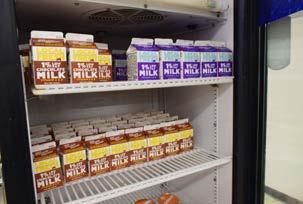
3 minute read
Pricing Perspective
Food for thought: would you go to a store without knowing the prices and proceed to buy items from that establishment? Many Lindbergh High School students are unaware of the fact that à la carte items are priced separately and are more expensive when not adding a fruit or vegetable and milk to their meals. The solution to clear the confusion on food pricing and inform students is to create a lunch system that offers transparency and clarification, aiming to stop students from going into a negative balance in their lunch accounts. Lindbergh High School has been under construction for the new school since 2019. Alongside the new building, Lindbergh and the Southwest Foodservice Excellence Program (SFE) have changed how students grab lunch throughout the building. In the new building, there are a total of three Flyer Cafes as well as the North cafeteria and South cafeteria that serve as a grab-and-go system for students to buy food during power lunch. With a variety of options for different foods at different locations, problems do arise. While our food service works hard to overcome these hardships, the number of students that attend Lindbergh, and that buy lunch, open the opportunity to let things fall into the cracks. One of the main issues that have arisen is the lack of transparency when it comes to school lunch prices. Most students are unaware that getting a full meal with all of the food groups is cheaper than if they just bought à la carte items. For example, students that buy the whole meal will pay $3.30 compared to a student who got an à la carte item, like Bosco sticks, which cost $4.50.
Jenny Schira, the Administrative Assistant to the Food Service Director at Lindbergh, sheds light on how important it is for certain students to buy a whole meal and how if protocols are ignored it will not only cost the students, but the school as well. She states, “When a representative from the Missouri Department of Elementary and Secondary Education will be here for next year to assess us, he or she will come down or stand behind a cashier. They will watch as kids come through the lunch lines and monitor what’s on their trays. If they don’t have all three of those components present and we claim it as a meal, we’ll be fined. So, we have to make sure that when students are buying their lunch that we are being very observant as to what the kids are having and we’re charging them appropriately.”
Advertisement
The SFE runs an offer vs. serve program, which enables students to have a variety of options. They must follow the meal standards provided by the USDA (United States Department of Agriculture) and DESE (Missouri Department of Elementary and Secondary Education) for appropriate serving sizes and restrictions to take part in this program. The school is monitored by DESE and must abide by all of its requirements when it comes to the standard of food and service. Every three to four years, DESE makes an assessment of the food service at Lindbergh. If the school is not following the set federally required rules, the school will receive an audit fine under the pretense that they are not following all of the necessary regulations. To help the food service staff struggle less with the audit, students should get the full intended meal that follows the USDA standards, containing all of the daily food groups.
It is essential to keep students informed on what foods they are required to get and how much they are buying them for in order to avoid issues such as going over their lunch balance, being fined and helping the school’s food service avoid becoming affected by the audit. The school does provide the necessary resources to obtain this information, but there is confusion regarding communication and many students don’t know where to look for prices or understand the importance of the resources offered, like the online menu for Lindbergh lunches. To locate the daily menus and their prices, going onto the website, Nutrislice, and typing in their school’s name will lead the students to the breakfast and lunch menus for the week.



There are questions that come up like, why don’t the students just simply ask about the prices? Realistically, a student could ask, but they wouldn’t want to have that task every single day. No one is pointing the blame at Lindbergh High School or the students, but simple changes, like making menu pricing obvious to students, will keep them aware of what lunch requirements they should follow and make students understand the importance of the resources that are available, which is the best solution to tackle issues with school lunch.





